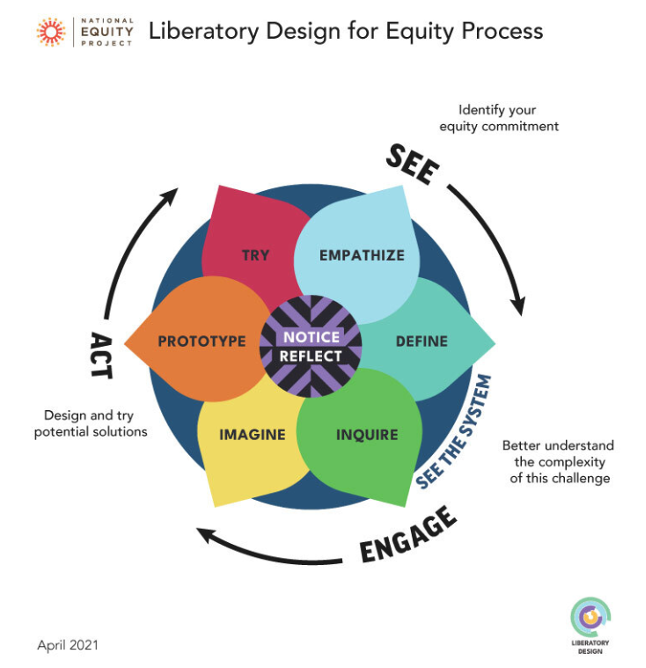April 28, 2023 | By Vanessa Coleman and Ela Joshi
When designing and scaling evidence-based educational products, it is critical to ensure they are relevant and accessible to the communities they aim to serve, or they might inadvertently cause harm.1, 2 When creating evidence-based products, designers should gather input from, or sufficiently consider, the people most impacted by problematic practices, policies, funding allocations, and organizational cultures. Without such input, designers miss opportunities to authentically co-create products that support equitable student outcomes and meet user needs.
Liberatory Design mindsets offer designers strategies for enabling an equity and learner stance in their design efforts, while modes provide a cyclical improvement process to guide design.
Liberatory Design is a human-centered approach to the design process
The result of a collaboration between Tania Anaissie, David Clifford, Susie Wise, and the National Equity Project (Victor Cory and Tom Malarkey), Liberatory Design is a human-centered design process that uses design thinking to address the root causes of inequities. As illustrated in the figure below, Liberatory Design draws on principles of design thinking as well as equity-centered frameworks by offering a set of mindsets and modes. By closely aligning the design process with users’ needs and experiences, product designers using Liberatory Design may be able to interrupt patterns of inequity found in typical design processes, center people’s lived experiences, and focus on the broader context of the challenge rather than addressing an isolated issue.

Source: Introduction to Liberatory Design, by National Equity Project.
Note: The figure displays the eight modes of Liberatory Design. For more information, see the Liberatory Design website.
Positionality refers to the various identities that shape an individual’s perspective and experiences—race, ethnicity, gender, socioeconomic status and background, religious beliefs, national origin, cultural background, and other identities.
Applying Liberatory Design can support scaling an evidence-based product to a larger audience
Scaling requires careful planning, strategic thinking, and a clear understanding of the market and audience. Importantly, scaling requires the product to be usable and relevant to user needs.
Liberatory Design encourages designers to be more reflective and intentional in their approach to innovation, aiming to create more equitable, sustainable, and relevant solutions. Liberatory Design emphasizes a few ways to improve the process of scaling evidence-based products:
- Prioritize designer self-reflection: By reflecting on their positionality and their influence on the design process and outcomes, designers can become more aware of their biases and assumptions. This awareness can help them minimize the effects of their biases and assumptions on their approach to innovation and motivate them to better understand the needs and experiences of different users and communities. Designers can also examine and acknowledge the power dynamics within the design process. They can, for example, consider the role of invested communities, such as users and customers, and the impact of the design process on them.
- Incorporate diverse perspectives: By bringing together people with different backgrounds, experiences, and viewpoints, designers can create solutions that are more inclusive and accessible, which can improve their ability to reach a wider audience.
- Center the voices and needs of those most impacted by the educational challenge: By engaging the people most impacted by the identified challenge (the inspiration for the product) and centering their voices in the design process, designers can create solutions that are more responsive to the needs of diverse communities. Doing so can also improve the scalability and impact of their products
- Acknowledge and address systemic issues: By developing solutions that address the systemic issues contributing to social inequities and oppression, designers can create more sustainable and impactful products in the long term.
The LEARN Network is integrating principles of Liberatory Design into SRI’s Invent-Apply-Transition Framework to support four product teams that are preparing to scale evidence-based educational products to accelerate students’ learning in reading and math to address COVID-19 learning loss. The Network will share tools and resources from this work with researchers and developers at large through the LEARN Network website.
For example, product designers may use Liberatory Design’s empathy mode to engage authentically with end users. Product teams may reflect on or gather information on the following questions:
- Who is closest to the identified educational challenge? Who has least proximity to the power to address the challenge?
- Who is directly or indirectly influencing the conditions related to the challenge?
- How might we learn more about the challenge by building relationships instead of creating transactional experiences?
- How might a designer’s identity and social experiences affect how they perceive challenges and the individual’s most impacted by them?
- How might we maintain a learning stance instead of starting with solutions?
References
2Golann, J. W. (2021). Scripting the moves: Culture and control in a “no-excuses” charter school. Princeton University Press.
3Coburn, C. E. (2003). Rethinking scale: Moving beyond numbers to deep and lasting change. Education Researcher, 32(6), 3–12. https://www.sesp.northwestern.edu/docs/publications/139042460457c9a8422623f.pdf
